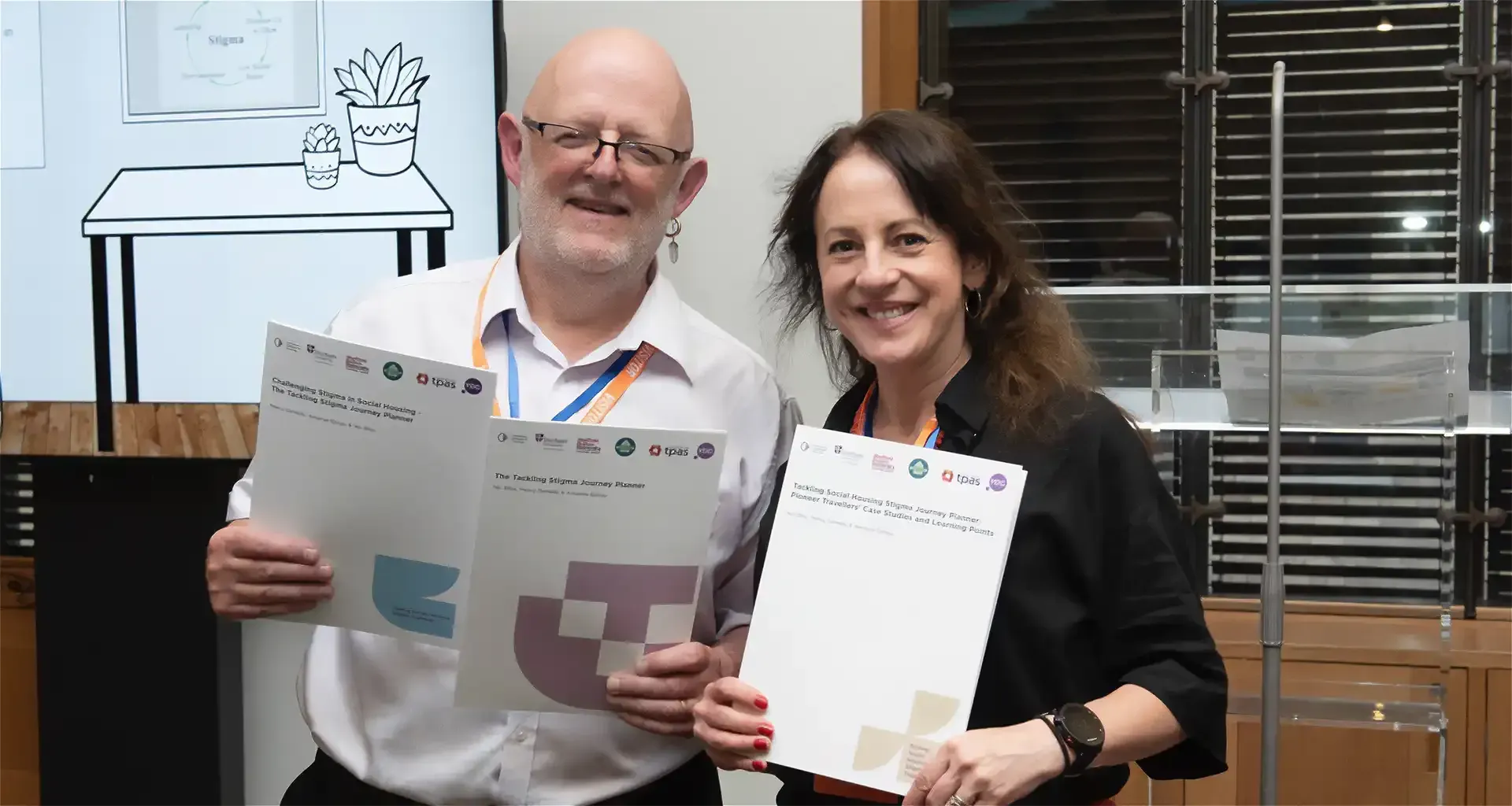Recently in the UK, Stop Social Housing Stigma formally launched its Tackling Stigma Journey Planner at a parliamentary event. With stigma also proving an ongoing problem in Australasia's social housing context, we're sharing this article by CIH's Alma Sheren speaking with campaign director Nic Bliss about the work behind the framework and how it supports landlords and residents in ending stigma together.

Social housing plays a vital role in providing secure, affordable homes for millions across the UK. Despite this, tenants continue to face deep-rooted stigma in various forms, which is often exacerbated by negative media portrayals, including outdated stereotypes, fuelling further public discourse.
The Stop Social Housing Stigma (SSHS) campaign was born out of a need to challenge these misconceptions and advocate for a more respectful, tenant-led approach to housing policy. As one of the campaign’s partners, CIH has been actively involved with the group and its cohorts on developing a Tackling Stigma Journey Planner, which, alongside associated resources, such as case studies and a new report, was officially launched this week in parliament.
We caught up with campaign director Nic Bliss about the group’s critical role in driving tenant-landlord collaboration to tackle social stigma, and what’s next for the campaign.
The journey so far
SSHS emerged in the wake of the Grenfell Tower tragedy, where tenants highlighted stigma as one of their most pressing concerns, ranking higher than issues such as repairs and safety. The campaign was founded as a tenant-led movement, bringing together residents, housing providers and policymakers to reshape the narrative around social housing.
Since its inception in 2017, the group has worked tirelessly to amplify tenant voices, push for policy changes and encourage landlords to engage more meaningfully with their communities. The campaign has gained traction among housing associations, local councils and advocacy groups, all pledging a commitment to ripping out stigma at the root.
Over the years, SSHS has spearheaded initiatives to challenge stereotypes, including promoting positive tenant stories and engaging landlords in meaningful dialogue. The campaign has also worked closely with policymakers and organisations, such as the CIH, to ensure that tackling stigma remains a priority.
One of the most significant developments of the campaign has been the recognition of stigma at government level. Crucially, the current Prime Minister and Deputy Prime Minister have both publicly acknowledged the need for a cultural shift across the sector, emphasising that regulation alone is not enough to address the issue.
The Tackling Stigma Journey Planner
A major milestone in the campaign has been the official parliamentary launch of the Tackling Stigma Journey Planner, alongside a series of case studies and a new report, in early May.
Along with CIH, the planner has been developed in collaboration with Durham University, Sheffield Hallam University, TPAS and YD Consultants. The practical framework for the project is specifically designed to help tenants and landlords work together to combat stigma using a variety of means.
In its early stages, the framework began life as a toolkit. As the campaign evolved, however, there were concerns that it could end up becoming just another box to tick. A more cultural focus was developed, bringing both tenants and landlords together to tackle the various practical issues that tenants experience through stigma.
“CIH and our other partners had been talking about formulating this long before I came along,” Nic says. “We really didn’t want it to be a tick-box—it’s very much a journey, and we still don’t know where this journey is going to lead us. The most important thing is that we’re all on it together.”
After Grenfell, the campaign helped organise various events, such as ministerial roadshows, where tenants identified tackling stigma as a key priority; many tenants said they felt like they were treated as second-class citizens.
“This experience is partly due to the wider societal environment, including the press and the media,” Nic says. “But the other side of it is the experiences tenants have with their landlords and how landlords engage with them.”
“The journey planner has a stronger focus on this aspect,” he adds, citing a recent G15 report that highlights the continuing discrimination faced by social housing residents due to their living environments.
The report surveyed 3,000 social housing residents across London, finding nearly half of tenants felt stigmatised, with the most common source of stigma being interactions with landlords. Residents who took part in the survey also highlighted media portrayals of social housing and residents as the “most significant driver of negative perceptions”.

The revised Tackling Social Housing Stigma Planner aims to provide a structured approach for housing providers to assess their practices, engage with tenants and implement changes that foster respect and fairness.
Among other tools, the new framework includes a Fair Press for Tenants guide, which has been produced by people living in social housing to help journalists and other media workers report fairly.
As well as hosting updated policy briefings and reports, the planner includes case studies from ‘pioneer travellers’ (landlords), who have piloted stigma-reduction initiatives, offering valuable insights for others across the sector to learn from. There are also tenant videos, where tenants and other guests talk about social housing stigma and what it means to them.
Rachael Williamson, Director of Policy, Communications and External Affairs, attended the parliamentary launch of the planner. She said, “This work is a powerful example of what can be achieved when tenants and landlords come together to drive meaningful change."
"Tackling stigma is essential to creating a fairer, more respectful housing system — and we’re delighted to support this tenant-led campaign in challenging outdated perceptions and championing the voices of social housing residents.”
CIH policy manager Sarah Davis was closely involved in the development of the planner and its associated resources. She said, “The Journey Planner and all the tools provide some real support for landlords to tackle stigma head-on. It's great that CIH could support this."
The road ahead
While the launch of the Journey Planner marks a significant step forward, the fight against social housing stigma is far from over. SSHS continues to advocate for tenant-led solutions, urging landlords to prioritise fair treatment, respect and meaningful engagement.
“We’re still a small organisation, albeit with a fantastic committee of tenants working towards building greater momentum,” says Nic. “But this is about the sector addressing this [issue] as a whole.
“We want to get a positive message out to both landlords and tenants that they have the power to tackle this together, and there are a variety of ways that they can do this.”
The power of tenant-landlord cooperation is something Nic is familiar with, having spent around 30 years living in the tenant-led 20/20 Housing Co-operative where he grew up in Birmingham.
“I lived in a 49-home cooperative, which my fellow tenants and I controlled,” he says, “which means that I didn’t feel stigma in quite the same way as many other tenants because we were in a position to change things.”
Having that positive tenant experience and the power to steer change is something that Nic wants all housing tenants to experience, and he’s keen to emphasise that the campaign is largely driven by its tenant committee members.
“It’s also an important vehicle for framing the various complexities that make up social housing stigma and what is being done to tackle it in a digestible, relatable way that tenants can engage with.”
How can UK landlords get involved?
SSHS is encouraging UK landlords to join the campaign via the website, where individuals can also join. “It’s free to sign up,” Nic says. “We’re also encouraging landlords to get in touch with us and have a dialogue with us.
“We’d love to hear from people about what they are doing to tackle social housing stigma, and how this can be shared with others across the sector to amplify the experience.”
With growing support from housing providers, policymakers and tenants, SSHS is helping to pave the way for a more inclusive, respectful social housing sector—where stigma is no longer an accepted reality, and tenant power is reframing what it means to be a part of the social housing community.
Speaking at the launch event on 19th May, Nic says, “We'll know it's cut through when landlords are using [the framework] because they know it's the right thing to do, and not because the Regulator or Ombudsman expect it.”
All images courtesy of Stop Social Housing Stigma
Share This Article
Other articles you may like






